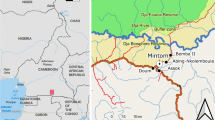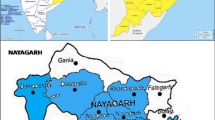Abstract
Famine Foods of Brazil’s Seasonal Dry Forests: Ethnobotanical and Nutritional Aspects. Famine foods are used by people in times of food scarcity. Although the northeast of Brazil regularly faces periods of drought that cause a shortage of traditional foods, the use of famine foods is insufficiently recorded. The purpose of this study was to record the knowledge of famine food in two rural Caatinga communities, Carão and Cachoeira, in the states of Pernambuco and Paraiba, respectively, and to determine the chemical composition of the major famine foods utilized. The ethnobotanical aspect was divided into two stages: free lists and semistructured interviews. Based on the interviews, the main famine foods known by communities were selected for nutritional analysis. The study revealed that certain foods are used by communities only in times of shortages. Carão showed a higher species richness than Cachoeira, but the food knowledge was more widespread among the interviewees in Cachoeira. In Carão, the main species mentioned were Dioclea grandiflora and Manihot dichotoma, whereas in Cachoeira, Encholirium spectabile and Pilosocereus gounellei were the major species indicated. The species examined had a high carbohydrate content, especially D. grandiflora, Manihot glaziovii, and M. dichotoma, and could be used for complementary feeding of the population if adverse effects could be minimized. Mandevilla tenuiflora is indicated for future studies of potential agro-industrial applications and the beneficial aspects of its root, which could represent an alternative source of income for the population.
Resumé
Aspectos etnobotânicos e nutricionais de alimentos emergenciais usados em florestas estacionais secas do Nordeste do Brasil. Os alimentos emergenciais são aqueles que as pessoas consomem apenas em tempos de escassez de alimentos. Muito embora a população da região Nordeste do Brasil enfrente períodos de seca que provoca a falta dos alimentos oriundos da agricultura, o uso dos alimentos emergenciais é pouco registrado. O objetivo deste estudo foi registrar o conhecimento sobre alimentos emergenciais em duas comunidades rurais da Caatinga e determinar a composição química dos principais alimentos conhecidos. O estudo foi conduzido no município de Altinho, estado de Pernambuco e no município de Soledade, estado da Paraíba. O trabalho etnobotânico foi dividido em duas etapas: lista livre e entrevistas semi-estruturadas. Com base nas entrevistas, selecionaram-se para a análise nutricional os principais alimentos conhecidos pelas comunidades. O estudo revelou que as comunidades conhecem espécies alimentícias consumidas apenas em períodos de escassez alimentar. Carão tem maior conhecimento que Cachoeira, no entanto, em Cachoeira o conhecimento é mais disseminado entre os informantes. Em Carão as principais espécies conhecidas foram Dioclea grandiflora e Manihot dichotoma, em Cachoeira foram Encholirium spectabile e Pilosocereus gounellei. As espécies analisadas têm alto teor de carboidratos, especialmente D. grandiflora, Manihot glaziovii e M. dichotoma que podem ser utilizadas na complementação da dieta da população se minimizados os seus efeitos colaterais. Por suas características Mandevilla tenuiflora é indicada para estudos futuros de seu potencial agroindutrial e beneficiamento de suas raízes, que podem representar uma fonte alternativa de renda para a população.


Similar content being viewed by others
Literature Cited
AESA-PB. 2012. Agência Executiva de Gestão de Águas do Estado da Paraíba. http://www.aesa.pb.gov.br/.
Albuquerque, U. P., R. F. P. Lucena, and N. L. Alencar. 2010. Métodos e técnicas para coleta de dados etnobiológicos. Pages 41–64 in U. P. Albuquerque, R. F. P. Lucena, and L. V. F. Cunha, eds., Métodos e Técnicas na Pesquisa Etnobiológica e Etnoecológica, 1st edition. NUPEEA, Recife, Brazil.
Alencar, N. L., T. A. S. Araújo, E. L. C. Amorim, and U. P. Albuquerque. 2010. The inclusion and selection of medicinal plants in traditional pharmacopoeias—Evidence in support of the diversification hypothesis. Economic Botany 64(1):68–79.
Almeida, C. F. C. B. R., M. A. Ramos, E. L. C. Amorim, and U. P. Albuquerque. 2010. A comparison of knowledge about medicinal plants for three rural communities in the semi-arid region of northeast of Brazil. Journal of Ethnopharmacology 127(3):674–684.
Araújo, E. L., C. C. Castro, and U. P. Albuquerque. 2007. Dynamics of Brazilian Caatinga: A review concerning plants environment and people. Funcional Ecosystems and Communities 1:15–28.
——— and E. M. N. Ferraz. 2010. Análise da vegetação nos estudos etnobotânicos. Pages 223–253 in U. P. Albuquerque, R. F. P. Lucena, and L. V. F. Cunha, eds., Métodos e Técnicas na Pesquisa Etnobiológica e Etnoecológica, 1st edition. NUPEEA, Recife, Brazil.
Araújo, T. A. S., N. L. Alencar, E. L. C. Amorin, and U. P. Albuquerque. 2008. A new approach to study medicinal plants with tannins and flavonoids contents from the local knowledge. Journal of Ethnopharmacology 120(1):72–80.
AOAC (Association of Official Agricultural Chemists). 2006. Official methods of analysis of the Association of Official Analytical Chemistry, 18th edition. A.O.A.C., Washington, D.C.
Ayres, M., M., Jr. Ayres, D. L. Ayres, and A. S. Santos. 2007. Bioestat versão 5.0: Aplicações estatísticas nas áreas das ciências bio-médicas. Tefé-Sociedade Civil Mamirauá/MCT CNPq, Belém-PA, Brazil.
Balemie, K. and F. Kebebew. 2006. Ethnobotanical study of wild edible plants in Derashe and Kucha Districts, South Ethiopia. Journal of Ethnobiology and Ethnomedicine 9:1–9.
Begossi, A. 1998. Resilience and neotraditional populations: The caiçaras (Atlantic Forest) and caboclos (Amazon, Brazil). Pages 129–157 in F. Berkes and C. Folke, eds., Linking social and ecological systems for resilience and sustainability. Cambridge University Press, Cambridge, U.K.
Cagnon, J. R., M. P. Cereda, and S. Pantarotto. 2002. Cultura de tuberosas amiláceas latino-americanas. In: CD-rom Série: Cultura de tuberosas amiláceas latino-americanas, Vol. 2. Fundação Cargill, Brazil.
Castro, J. 1967. Geografia da Fome. Editora Brasiliense, São Paulo, Brazil.
———, E. Pechnick, and O. Parahim. 1947. Os alimentos bárbaros dos sertões do Nordeste. Arquivos Brasileiros de Nutrição 3(2):5–29.
Chaves, N., N. R. Teodósio, O. G. Lima, and W. Pessoa. 1948. A mucunã vermelha (Dioclea grandiflora Benth) na nutrição. Laboratório de Fisiologia da Faculdade de Medicina da Universidade do Recife/Serviço Gráfico Jornal do Commercio, Recife, Brazil.
Chisté, R. C. and K. O. Cohen. 2008. Determinação de cianeto total nas farinhas de mandioca do grupo seca e d’água comercializadas na cidade de Belém-PA. Revista Brasileira de Tecnologia Agroindustrial 2(2):96–102.
CODEVASF (Companhia de Desenvolvimento do Vale do São Francisco). 2010. http://www.codevasf.gov.br/.
Colson, E. 1979. In good years and in bad: Food strategies of self-reliant societies. Journal Anthropology Research 35:18–29.
Conover, W. J. 1971. Practical nonparametric statistics. John Wiley and Sons, New York.
Cunha, E. 1902. Os Sertões—Campanha de Canudos. Laemmert, Rio de Janeiro.
Eyssartier, C., A. H. Ladio, and M. Lozada. 2008. Cultural transmission of traditional knowledge in two populations of north-western Patagonia. Journal of Ethnobiology and Ethnomedicine 4:25. http://www.ethnobiomed.com/content/4/1/25.
FIDEM. 2010. Agência Estadual de Planejamento e Pesquisas de Pernambuco. http://www.municipios.pe.gov.br/.
Francisco, M. S., J. M. B. Sousa, F. C. Medeiros-Júnior, M. C. Oliveira, R. T. Moreira, and E. E. Lima. 2008. Avaliação sensorial de biscoito a base de farinha de facheiro (Cereus squamosus). In: III Jornada Nacional da Agroindústria. Bananeiras, Brazil: Ciência e tecnologia de alimentos.
Gross, J. 1987. Pigments in fruits. Academic Press, London.
Grosskinsky, B. and C. Gullick. 2001. Potential of indigenous food plants to support and strengthen livelihoods in southern Sudan. In: The potential of indigenous wild foods, eds. C. Kenyatta, and A. Henderson, 2–5. USAID/OFDA, CRS/Southern Sudan. http://pdf.usaid.gov/pdf_docs/PNACL441.pdf.
Guinand, Y. and D. Lemessa. 2001. Wild-food plants in Ethiopia: Reflections on the role of wild foods and famine foods at a time of drought. In: The potential of indigenous wild foods, eds. C. Kenyatta, and A. Henderson, 31–46. USAID/OFDA, CRS/Southern Sudan. http://pdf.usaid.gov/pdf_docs/PNACL441.pdf.
Höft, M., S. K. Barik, and A. M. Lykke. 1999. Quantitative ethnobotany: Applications of multivariate and statistical analyses in ethnobotany. UNESCO, Paris, France.
Irvine, F. R. 1952. Supplementary and emergency food plants of West Africa. Economic Botany 6:23–40.
Lees, D. H. and F. J. Francis. 1972. Standardization of pigment analyses in cranberries. HortScience 7:83–84.
Lins Neto, E. M. F., N. Peroni, and U. P. Albuquerque. 2010. Traditional knowledge and management of Umbu (Spondias tuberosa, Anacardiaceae): An endemic species from the semi-arid region of northeastern Brazil. Economic Botany 64(1):11–21.
Lozada, M., A. H. Ladio, and M. Weigandt. 2006. Cultural transmission of ethnobotanical knowledge in a rural community of northwestern Patagonia, Argentina. Economic Botany 60(4):374–385.
Merrill, A. L. and B. K. Watt. 1973. Energy value of foods: Basis and derivation. United States Department of Agriculture, Washington, D.C.
Ministério da Saúde. 2002. Manual operacional para comitês de ética em pesquisa. Ministério da Saúde/Série CNS Cadernos Técnicos, Brasília.
Minnis, P. E. 2000. Famine foods of the North American desert borderland in historical context. Pages 214–239 in P. E. Minnis, ed., Ethnobotany: A reader. University of Oklahoma Press, Norman, Oklahoma.
Mori, A. S., L. A. M. Silva, and E. G. Lisboa. 1989. Manual de manejo do herbário fanerogâmico. Centro de Pesquisa do Cacau, Ilhéus-Bahia, Brazil.
Nascimento, V. T., Moura, N. P., Vasconcelos, M. S. S., Maciel, M. I. S., and U. P. Albuquerque. 2011. Chemical characterization of native wild plants of dry seasonal forests of the semi-arid region of northeastern Brazil. Food Research International 44: 2112–2119.
Peel, M. C., B. L. Finlayson, and T. A. McMahon. 2007. Updated world map of the Köppen-Geiger climate classification. Hydrology and Earth System Sciences 11:1633–1644.
Rahamani, M. M. 1978. The causes and effects of famine in the rural population: A report from Bangladesh. Ecology of Food and Nutrition 7:99–102.
Rodriguez-Amaya, D. B. 1999. Latin American food sources of carotenoids. Archivos Latinoamericanos de Nutrición 49:74–84.
Sá e Silva, I. M. M., L. C. Marangon, N. Hanazaki, and U. P. Albuqueruque. 2009. Use and knowledge of fuelwood in three rural caatinga (dryland) communities in NE Brazil. Environment, Development and Sustainability 11(4):833–852.
Sokal, R. R. and F. J. Rohlf. 1995. Biometry: The principles and practices of statistics in biological research. W. H. Freeman and Co., New York.
TACO (Tabela Brasileira de Composição de Alimentos). 2006. Campinas. NEPA-UNICAMP, Säo Paulo, Brazil.
Vicenzi, R. 2010. Apostila: Introdução uma análise de alimentos. Química Industrial de Alimentos–UNIJUI. http://www.ebah.com.br/login?redirect=/content/ABAAABnFEAE/apostila-analise-alimentos.
Acknowledgments
The authors would like to thank the communities of Carão and Cachoeira for accepting us and helping us perform this study; the Mayor’s Office of the municipality of Altinho for logistic support, especially the Secretary of Agriculture Sr. Miguel Andrade Júnior; the Lucena family for support in Soledade, especially Dr. Reinaldo Farias Paiva de Lucena; FACEPE and CNPq for financial support and the productivity grant awarded to Dr. U.P. Albuquerque; and Dr. Robert Voeks for his help improving our manuscript.
Author information
Authors and Affiliations
Corresponding author
Rights and permissions
About this article
Cite this article
do Nascimento, V.T., Vasconcelos, M.A.d., Maciel, M.I.S. et al. Famine Foods of Brazil’s Seasonal Dry Forests: Ethnobotanical and Nutritional Aspects. Econ Bot 66, 22–34 (2012). https://doi.org/10.1007/s12231-012-9187-2
Received:
Accepted:
Published:
Issue Date:
DOI: https://doi.org/10.1007/s12231-012-9187-2




